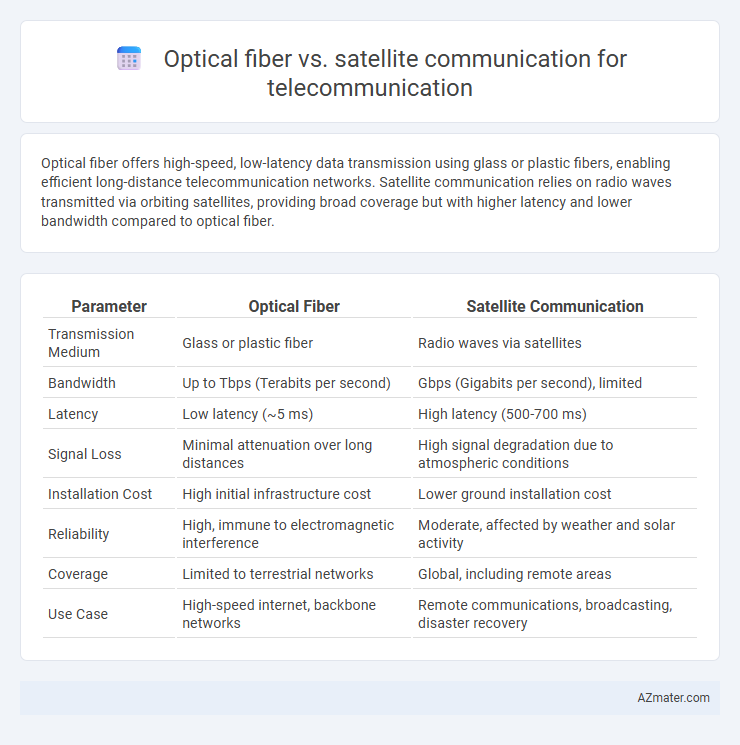Optical fiber offers high-speed, low-latency data transmission using glass or plastic fibers, enabling efficient long-distance telecommunication networks. Satellite communication relies on radio waves transmitted via orbiting satellites, providing broad coverage but with higher latency and lower bandwidth compared to optical fiber.
Table of Comparison
| Parameter | Optical Fiber | Satellite Communication |
|---|---|---|
| Transmission Medium | Glass or plastic fiber | Radio waves via satellites |
| Bandwidth | Up to Tbps (Terabits per second) | Gbps (Gigabits per second), limited |
| Latency | Low latency (~5 ms) | High latency (500-700 ms) |
| Signal Loss | Minimal attenuation over long distances | High signal degradation due to atmospheric conditions |
| Installation Cost | High initial infrastructure cost | Lower ground installation cost |
| Reliability | High, immune to electromagnetic interference | Moderate, affected by weather and solar activity |
| Coverage | Limited to terrestrial networks | Global, including remote areas |
| Use Case | High-speed internet, backbone networks | Remote communications, broadcasting, disaster recovery |
Introduction to Modern Telecommunication Technologies
Optical fiber communication offers high bandwidth and low latency, making it ideal for long-distance and high-speed data transmission in modern telecommunication networks. Satellite communication complements terrestrial networks by providing extensive coverage in remote or underserved areas where fiber deployment is challenging. Combining both technologies is essential for creating a resilient and globally accessible telecommunication infrastructure.
Overview of Optical Fiber Communication
Optical fiber communication utilizes thin strands of glass or plastic fibers to transmit data as light pulses, offering extremely high bandwidth and minimal signal loss over long distances, making it ideal for telecommunication networks. This technology supports faster data transfer rates and enhanced security compared to satellite communication, which relies on radio waves and can be affected by atmospheric conditions and latency issues. Optical fibers are widely deployed in undersea cables and urban infrastructure, forming the backbone of global internet and telephone connectivity.
Overview of Satellite Communication
Satellite communication utilizes orbiting satellites to transmit signals over vast distances, enabling global connectivity where terrestrial infrastructure is limited or unavailable. It supports broadband, television, and voice communication by relaying data between remote locations via geostationary, low-Earth orbit, or medium-Earth orbit satellites. Despite higher latency compared to optical fiber, satellite communication provides critical coverage for maritime, rural, and disaster-affected regions, complementing terrestrial networks in telecommunication systems.
Signal Transmission and Speed Comparison
Optical fiber communication offers superior signal transmission with minimal attenuation and high bandwidth capacity, enabling data transfer speeds up to terabits per second over long distances. Satellite communication experiences higher latency and signal degradation due to atmospheric interference and the long travel distance of radio waves to and from orbiting satellites, typically providing speeds in the range of megabits to low gigabits per second. Optical fibers are preferred for high-speed, reliable telecommunication infrastructure, while satellites serve remote areas where fiber deployment is impractical.
Bandwidth Capabilities: Optical Fiber vs Satellite
Optical fiber communication provides significantly higher bandwidth capabilities compared to satellite communication, enabling data transmission rates in the terabits per second range, ideal for high-capacity networks and data centers. Satellite communication bandwidth is limited by available spectrum and signal attenuation, typically supporting data rates in the range of gigabits per second, suitable for broad-area coverage rather than ultra-high-speed connectivity. The superior bandwidth efficiency of optical fibers results from low signal loss and high-frequency transmission, making them the preferred choice for backbone telecommunication infrastructure.
Reliability and Latency Differences
Optical fiber communication offers superior reliability with minimal signal degradation and is less susceptible to environmental interference compared to satellite communication, which can be affected by weather conditions and atmospheric disturbances. Latency in optical fiber is significantly lower, typically around 5-10 milliseconds for long-distance transmissions, while satellite links experience higher latency often exceeding 500 milliseconds due to the long distances signals must travel to geostationary satellites. These factors make optical fiber more suitable for latency-sensitive applications requiring consistent performance, while satellite communication is favored in remote areas lacking terrestrial infrastructure.
Infrastructure and Deployment Considerations
Optical fiber communication offers high-capacity data transmission with low latency, requiring extensive physical infrastructure such as underground cables and signal repeaters, which can be costly and time-consuming to deploy, especially in remote or rugged areas. Satellite communication provides broad coverage with minimal ground infrastructure, enabling rapid deployment in underserved or hard-to-reach regions, but faces limitations like higher latency and bandwidth constraints due to signal travel distances and atmospheric interference. Choosing between the two depends on balancing deployment speed, geographical challenges, and performance requirements for telecommunication networks.
Cost Analysis: Installation and Maintenance
Optical fiber installation involves high initial costs due to trenching and cable laying but benefits from low maintenance expenses and long-term durability. Satellite communication requires less infrastructure investment but incurs ongoing costs from satellite launches, ground station upkeep, and higher latency-related operational expenses. Over time, optical fiber proves more cost-effective for high-volume data transmission, while satellite remains advantageous for remote areas with limited terrestrial infrastructure.
Applications and Use Case Scenarios
Optical fiber communication excels in high-speed data transmission for urban and long-haul telecommunication networks, supporting applications such as broadband internet, IPTV, and data centers due to its low latency and high bandwidth capacity. Satellite communication is ideal for remote, rural, and maritime areas where terrestrial infrastructure is limited, enabling applications like emergency response, global broadcasting, and mobile connectivity in hard-to-reach locations. Hybrid networks combining optical fiber and satellite links enhance overall coverage and reliability, optimizing performance for diverse telecommunication use cases across industries.
Future Trends and Technological Advancements
Optical fiber communication is advancing with innovations like space-division multiplexing and photonic integrated circuits, promising higher bandwidth and lower latency for future telecommunication networks. Satellite communication is evolving through the deployment of low Earth orbit (LEO) mega-constellations, providing global coverage and enhancing connectivity in remote areas. The convergence of optical fiber networks with satellite systems is expected to create a hybrid infrastructure that optimizes speed, capacity, and accessibility in next-generation telecommunications.

Infographic: Optical fiber vs Satellite communication for Telecommunication
 azmater.com
azmater.com